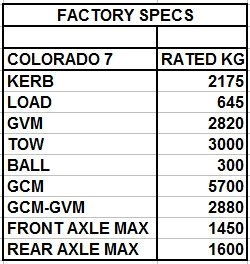Hi Folks,
Just thought Id open up a topic for discussion in relation to weight issues that many people encounter when towing larger caravans. Three weeks ago I had a long range fuel tank installed on my tow vehicle. I did a rough calculation on the extra weight that the full tank would add to the ute and was surprised at how close to GVM maximum I was going to be. After the installation, the ute was filled with fuel and packed with the gear that I was going to take away on a trip. With the coach sitting in the passengers seat, we went off to the local weigh bridge to get an idea of how we stacked up as far as weight was concerned. After adding the vans ball weight, I calculated that I had only 15kg up my sleeve if I was to be legal. That was a bit too close to the mark for my liking. If I throw a couple of slabs of beer in the back, Im over weight. Had to re- think weight distribution and packing to get a bit more breathing space. Even though the ute is rated as a one ton vehicle, every thing that you add cuts into that weight. A nudge bar, tow bar, canopy, drawer system, duel battery, fridge, tow ball weight, fuel, passengers and luggage all eat away at that magic number very quickly. If I had a bull bar and winch on the ute, I wouldnt be able to legally tow at all. Would be interested to hear peoples thoughts and creative ideas on this topic.
Cheers
Les
Just thought Id open up a topic for discussion in relation to weight issues that many people encounter when towing larger caravans. Three weeks ago I had a long range fuel tank installed on my tow vehicle. I did a rough calculation on the extra weight that the full tank would add to the ute and was surprised at how close to GVM maximum I was going to be. After the installation, the ute was filled with fuel and packed with the gear that I was going to take away on a trip. With the coach sitting in the passengers seat, we went off to the local weigh bridge to get an idea of how we stacked up as far as weight was concerned. After adding the vans ball weight, I calculated that I had only 15kg up my sleeve if I was to be legal. That was a bit too close to the mark for my liking. If I throw a couple of slabs of beer in the back, Im over weight. Had to re- think weight distribution and packing to get a bit more breathing space. Even though the ute is rated as a one ton vehicle, every thing that you add cuts into that weight. A nudge bar, tow bar, canopy, drawer system, duel battery, fridge, tow ball weight, fuel, passengers and luggage all eat away at that magic number very quickly. If I had a bull bar and winch on the ute, I wouldnt be able to legally tow at all. Would be interested to hear peoples thoughts and creative ideas on this topic.
Cheers
Les




